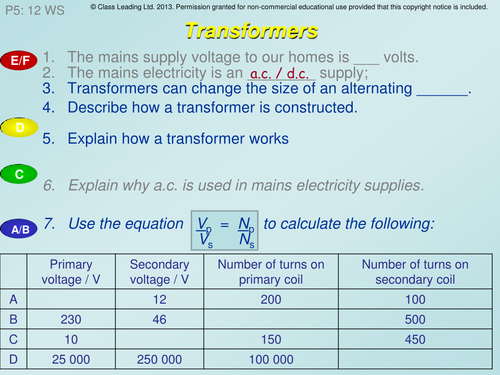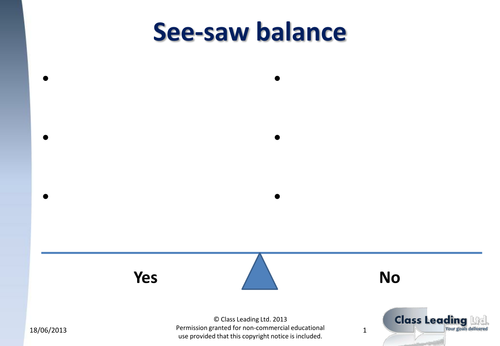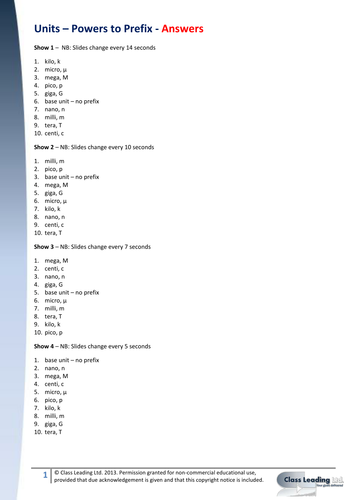314Uploads
262k+Views
194k+Downloads
Physics

Greenhouse Effect & Solar System - data handling
This activity follows on well from the Greenhouse effect starter. Based on interpreting data about planets in the solar system, it leads learners to the conclusion that Venus is hotter than it should be due to CO2. There are two levels of activity, the more demanding one explores the role of photons/light/radiation in heating planets. This activity was originally designed for 21st Century Science unit P2.
Please note that this is a non-editable resource. A premium editable version is also available at: https://www.tes.com/teaching-resource/resource-11858634
Key words: greenhouse effect, atmosphere, CO2, carbon dioxide, global warming

Work & change of energy - graded questions
This activity contains a powerpoint with graded questions & answers and matching pupil activity sheets, designed to be used at the end of a lesson and/or the start of the next lesson to review previous learning. The questions are based on the previous OCR 21st Century Science Specification unit P4, although could be used with other exam boards.\nClicking through the show reveals answers one a time. These reduce to A5 easily, the ideal size for most pupils. Please note grades are approximate.

Particles - Standard Model Flashcards
These flashcards, when printed out back-to-back and then cut out will produce a series of double sided flashcards showing the composition of particles in the standard model. They are good as an independent learning tool or revision activity. They could be used in preparation for the 'Identify the particle rolling slideshow Instant Engagement / Retrieval - available on TES Resources at:
https://www.tes.com/teaching-resource/resource-6341196

Eating a sandwich - modeling digestion
There are two parts to this activity, one is a practical activity to model the process of digestion. The other is a powerpoint slideshow to show what happens to the food on its journey through the body. If using with KS3 then the learning outcomes on the activity plan could also include breaking up of molecules in digestion. If using with KS2 for the new curriculum, the powerpoint will include some terms/slides that you may wish to miss out, so it has been left in an editable form.\nPlease ensure that you carry out a risk assessment before carrying out a practical activity.

Food chains and energy transfer - questions
This is a worksheet based activity that includes some higher order thinking to explore the ideas around energy transfer in simple food chains. Two versions are included, one with legacy GCSE grades, the other without. (please note that grade indications are only approximate). Why not try getting learners to choose a selection of questions to answer (e.g. do Q1-4 or Q3-8) An answer sheet is included.
This resource was originally designed for OCR 21st Century Science unit B3.
A premium editable version of this is available at: https://www.tes.com/teaching-resource/-11858631
Keywords: energy, transfer, food chain, efficiency

Transformers - graded questions
This activity contains a powerpoint with graded questions & answers and matching pupil activity sheets, designed to be used at the end of a lesson and/or the start of the next lesson to review previous learning. The questions are based on the previous OCR 21st Century Science Specification unit P5, although could be used with other exam boards.\nClicking through the show reveals answers one a time. These reduce to A5 easily, the ideal size for most pupils. Please note grades are approximate.

Identify the particle rolling slideshow PP - Instant Engagement / Retrieval
These are a sequence of PowerPoint slideshows designed to support the retrieval of the composition of particles in the standard model. They can be used as an instant engagement task (rolling on screen as students enter the room for immediate engagement with learning). They can also be used as a retrieval quiz. The slideshows are essentially the same task (with rearranged slides) but get progressively more demanding as the changeover of slide gets faster (as the numbers on the titles of the slideshows in brackets increase). Start the students with (1) and then as they get faster, use the more demanding versions.
This resource goes well with the particle flashcards also available on TES Resources at https://www.tes.com/teaching-resource/-6341199

The carbon cycle - grade questions
This activity contains a powerpoint with graded questions & answers and matching pupil activity sheets, designed to be used at the end of a lesson and/or the start of the next lesson to review previous learning. The questions are based on the previous OCR 21st Century Science Specification unit P2, although could be used with other exam boards.\nClicking through the show reveals answers one a time. These reduce to A5 easily, the ideal size for most pupils. Please note grades are approximate.

The Wave Equation - graded questions
This activity contains a powerpoint with graded questions & answers and matching pupil activity sheets, designed to be used at the end of a lesson and/or the start of the next lesson to review previous learning. The questions are based on OCR 21st Century Science Specification, although could be used with other exam boards.\nClicking through the show reveals answers one a time. There are two slightly different activity sheets for differentiation - one has key words, the other without. These reduce to A5 easily, the ideal size for most pupils. Please note grades are approximate.

Weighing up arguments - See saw writing frame
This resource is a collection of 6 slightly different see-saw balances that can be used with learners to help them develop the skills to weigh up an argument. The idea is that students will list reasons on both side of an argument (e.g. Should we have Nuclear Power?). They then use this to help make a decision. The scoring column on some sheets allows learners to score each argument out of a maximum of say 3. Add the scores on each side to see which has the stronger argument. This also includes phrases to support a more detailed conclusion. This was inspired by 21st Century Science.

Car efficiency - Data handling
Keywords: Efficiency, calculation, graph, skill, explain, justify, MAT.
This activity is designed to stretch the most able learners with some questions and tasks related to calculating efficiency. There are some demanding questions involving handling data and using graphs to make predictions. This was designed as a home learning task to consolidate learning about efficiency.
It would also make a suitable starter for AS/A level.
An answer sheet is included with suggested marks for each question.

Seismic Waves - graded questions
This activity contains a powerpoint with graded questions & answers and matching pupil activity sheets, designed to be used at the end of a lesson and/or the start of the next lesson to review previous learning. The questions are based on OCR 21st Century Science Specification, although could be used with other exam boards.\nClicking through the show reveals answers one a time. There are two slightly different activity sheets for differentiation - one has key words, the other without. These reduce to A5 easily, the ideal size for most pupils. Please note grades are approximate.

Evidence for climate change - data handling
This is a short standalone activity linked with the topic of climate change, global warming and icecap melting. It is intended to develop higher-order thinking skills and understanding of data. It aims to provide an opportunity for cognitive conflict and discussion.
There are two ways this task can be attempted:
Allow the students to work through the first two set of tasks sequentially. Hand out only the sheet with a triangle in the top right of the page. When this is completed, hand out only the sheet with the square. Finally, when this is completed give out the third and final sheet with questions 4 onwards.
Alternatively…
One half of class is given the first sheet, marked with a triangle. The other half is given the ones marked with a square. Pupils work on their own sheets independently. After a few minutes, pupils who have completed different sheets pair up. They compare their sheets and answer the questions on the third sheet together.
When this was tested, pupils responded well to the tricky questions.

Maths Skills - Units - Powers to Prefix Starter
These are a sequence of powerpoint shows designed as an instant engagement task (rolling on screen as learners enter the room for immediate engagement with learning). Learners write down the prefix that represents the power of ten multiplier. They are essentially the same task (with rearranged slides) but get progressively more demanding (as the changeover of slide gets faster) as the numbers in brackets increase. Start the students with (1) and then as they get faster, use the more demanding versions.

Active modelling - String vs mobile phone
Keywords: digital, analogue, encode, decode.
Notes: This activity helps learners compare how a simple string telephone works against a more complex digital system. Get the students to make string telephones using paper/plastic cups and lengths of string before attempting to complete the sheet. This helps explain an abstract idea by building up from a very hands on simple (more concrete) example. It really engages learners of all abilities. There is an activity sheet and a guidance sheet with answers. This was originally designed for OCR 21st Century Science unit P2

Engaging 'hats' model of electric circuits
Keywords: circuit, model, current, charge, electron, hats
This is an engaging model for students to participate in modelling electric circuits. It is aimed at KS3, but has been used successfully with KS4 and KS5. It helps students build a coherent model to explain circuits, although alternative models help explain energy transfers and potential difference (voltage) better.
Please note that this was originally published a number of years ago as part of the North Yorkshire Success for All project.
A premium PowerPoint slideshow that provides a visual model of the motion of charges in the circuit is also available at https://www.tes.com/teaching-resource/resource-12613884

Ohm's Law - graded questions
This activity contains a powerpoint with graded questions & answers and matching pupil activity sheets, designed to be used at the end of a lesson and/or the start of the next lesson to review previous learning. The questions are based on the previous OCR 21st Century Science Specification unit P5, although could be used with other exam boards.\nClicking through the show reveals answers one a time. These reduce to A5 easily, the ideal size for most pupils. Please note grades are approximate.

Resistance - graded questions
This activity contains a powerpoint with graded questions & answers and matching pupil activity sheets, designed to be used at the end of a lesson and/or the start of the next lesson to review previous learning. The questions are based on the previous OCR 21st Century Science Specification unit P5, although could be used with other exam boards.\nClicking through the show reveals answers one a time. These reduce to A5 easily, the ideal size for most pupils. Please note grades are approximate.

Force & Change of momentum - graded questions
This activity contains a powerpoint with graded questions & answers and matching pupil activity sheets, designed to be used at the end of a lesson and/or the start of the next lesson to review previous learning. The questions are based on the previous OCR 21st Century Science Specification unit P4, although could be used with other exam boards.\nClicking through the show reveals answers one a time. These reduce to A5 easily, the ideal size for most pupils. Please note grades are approximate.

Evaluating websites from URLs
This resource is a short powerpoint show and a pdf of the first slide. The idea is that learners read the URLs for a series of websites and decide whether they are trustworthy. They could put them into one of say three categories (e.g. High, Medium. Low).This is great for stimulating debate amongst learners, especially if the task is completed as a group. It is very effective when learners are asked to explain their reasoning. The powerpoint show can then be used to develop understanding further.




















